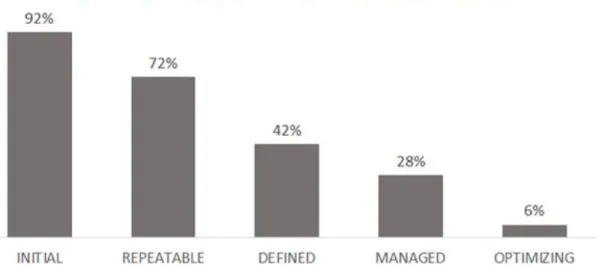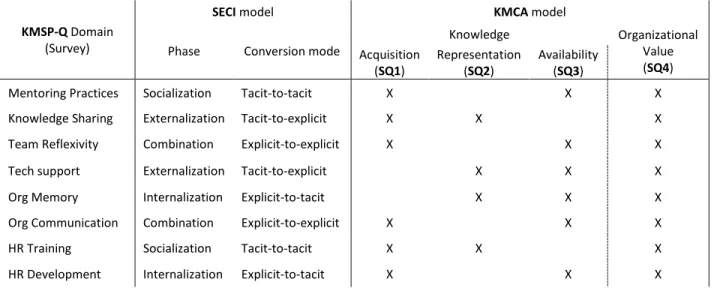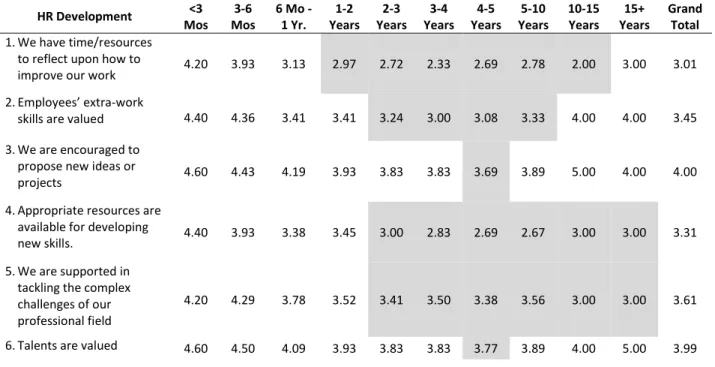Area Of Inquiry
- Partner Organization
- Phenomenon to Study
- Managing Knowledge Effectively
- Problem of Practice and Study Questions
- Research Relevance, Significance, and Approach
With this latest leveraged buyout, and to remain competitive during this transition period, the company needs to assess its knowledge management. The phenomenon to be studied is: How a company can improve its knowledge management processes to remain competitive.
Research Synthesis and Methods
Introduction
Through a systematic literature review, Castaneda et al. 2018) agree that the field of knowledge management has absorbed the domain of organizational learning. As such, we are leveraging evidence-based best practices from peer-reviewed research in the field of knowledge management for competitive results.
Key Concepts
Explicit knowledge is structured knowledge that an organization can express, articulate, document, store, digitally transfer and make readily available (Levy et al., 2021). An organization must design technologies around its values, need for collaboration and the leaders' vision (King, 2009; Lampel et al., 2009).
Knowledge as a Competitive Advantage
Market leaders and innovators know how to effectively create and manage knowledge as a resource (Jalali et al., 2014: Schutt, 2003). As such, an organization must provide mechanisms to catalyze staff interaction, communication and social bonding (Tatachari et al., 2014).
Further Research to Inform Our Study
They designed a multidimensional questionnaire called the Knowledge Management SECI Processes Questionnaire (KMSP-Q), based on Nonaka's SECI model and knowledge process theory. King's (2009) research on the knowledge management process cycle utilizes the SECI model and incorporates critical organizational outcomes such as innovation and collective learning.
Organizational Excellence Concepts
These enablers are essential to our study because they describe the goals of managing knowledge (vision), set methods to achieve these goals (strategy), provide guidelines for managing knowledge (structure), articulate the components by which knowledge is grounded. and converted (system). Our study looked for mechanisms in place for staff to be motivated to learn and share their expertise.
The KMCA Concept Model
Equally important for knowledge sharing is the embedding of knowledge management strategies in daily work processes, habits and norms (Mitra et al., 2015). Knowing what knowledge to use, when, where, and with whom—again, prioritizing mission-critical knowledge—drives organizational performance (Ihrig & MacMillan, 2015).
Research Methodology/Design
We combined Nonanka's Ba (2008) with the Organizational Performance component of King's (2009) Knowledge Management process to describe knowledge outcomes, impact and value. Using this approach, we can discover and describe what and how employees experience knowledge management and value creation in their organization.
Data Collection
- Site, Participant Selection, and Other Criteria
- Validity Strategies Addressed and Details
- Threats to Validity and Rigor
- Data Collection Conceptualization and Operationalization
Understand the culture of knowledge, the events that helped shape the company and what is shaping the new direction. We used The Company's Customer Experience platform, which includes a survey engine and provides a standard survey link.
Data Analysis
Data Analysis Process
We requested and collected materials from the company on various topics and for various purposes. We conducted Internet and Vanderbilt library searches of the company's time as a start-up, their transition to a public entity, and then back to private acquisition. We received training documentation and emails that showed how management approaches various projects, such as COVID-19 and the company's transitions from private to public.
Additionally, we received short white papers and case studies on how the Company engages with customers. We leveraged the Company's Customer Experience platform, which uses artificial intelligence (AI) and sophisticated Natural Language Programming (NLP) algorithms to analyze text. The company's AI algorithm captures each signal and unifies what the employee thinks, feels and does, using emotional logic and behavioral analysis.
We worked with the company's expert technology team to train the text analyzer to recognize topics and replicate the tool configuration. Given the limited time, our study stopped short of leveraging AI to its full potential (ie, we did not incorporate operational results into behaviors and experiences).
Interview Coding and Analysis
The text analyzer parses the submitted text, categorizes its parts and analyzes the feeling of "waiting too long". Using natural language processing, it derives emotions and identifies themes. Employees are not clear on how to get knowledge from internal sources, "Eventually you will get the right person who has the innate knowledge to help you answer." (P5, personal communication, June 29, 2022). At the same time, the founding culture that encouraged knowledge sharing is still there to some extent, "a lot of the ways we operate here are based on relationships." (P8, personal communication, August 10, 2022).
Basically, however, the company's managers do not intentionally acquire or structure knowledge, and there is no support or a clear path for knowledge sharing, transfer or acquisition, "I don't know if there are many other people that I would trust to help." (P2, personal communication, June 17, 2022). So that we're building specific processes and policies for [our division] things makes me very happy, and I think that's going to be the most valuable thing to do in the next year because right now our turnover rate is high." (personal communication, 30 June 2022). So sometimes it's frustrating because you don't know the exact place where you can find it." (personal communication, June 16, 2022).
I think the knowledge has left the building and we haven't captured it, right." (personal communication, June 20, 2022). In particular, there is employee turnover and new employees are burned out. "But I think we have some turnover due to a lack of information exchange regarding the second half of the acquisition." (P5, personal communication, July 29, 2022).

Documentation: Automated Analysis
Employees have multiple technologies but need help figuring out how they can contribute to the company's knowledge. We attribute the balanced insights to the type of documents we received, such as marketing, onboarding and training. We conducted a content analysis of the company's Glassdoor employee review page to provide a baseline of how employees and interviewees view the company's culture and its approach to knowledge.
The company's Glassdoor site has an overall rating of 3.8 out of 5, based on more than 669 reviews left.
Surveys: Analysis
The data showed that knowledge flow, dissemination and sharing between units and throughout the organization is slow, stiff and inadequate. Additionally, the organization must identify ways to strengthen and communicate HR practices to this group. Although only 1.1% of the population is between 20 and 25 years old, the company must strengthen these practices if the organization wants to attract and retain young talent.
In contrast, as shown in Table 11, employees with 3 to 10 years of organizational experience seek more organizational communication, and those with 3 to 15 years rate HR training as inadequate. However, the data indicates that organizational memory and HR training activities must improve in order for these critical knowledge assets to continue to provide value to the organization and choose to remain with the company. The data shows that the organization has the technological infrastructure to support knowledge sharing, but that there are also opportunities to improve knowledge representation through strategic, deliberate, structured and institutionalized knowledge management processes.
Employees with less than six months in the organization rated HR development as effective in most areas and had sufficient time and resources available to reflect on and improve their work and skills. Furthermore, those with 4-5 years in the organization have the lowest scores in the human resource development domain.

Findings and Recommendations
Findings
Evidence shows that the Company must manage knowledge effectively before it can use it for innovation and exploit the benefits of knowledge management for competitive advantage. Specifically, the Company needs a knowledge management roadmap where it can identify knowledge and create a knowledge culture to capture the competitive and organizational value of knowledge. The data shows that the Company needs a corporate knowledge management program designed with centralized leadership and governance.
Without a knowledge management strategy, intellectual property and critical knowledge will continue to leave the company. Our findings indicate that the firm must improve all three conditions to enable knowledge flow mechanisms. The data showed that the current lack of knowledge support processes is a barrier to understanding how to represent knowledge and the value of the company's knowledge assets.
Therefore, our third finding is that the company needs to formalize methods of sharing and creating knowledge. The company must embed learning mechanisms into daily activities and standards to further support knowledge availability.
Recommendations
One method of creating knowledge and innovation is to acquire it, and the Company is doing this by acquiring companies. To become a learning organization, the Company must manage its knowledge to create value and start by implementing the four key recommendations outlined below. During our study, we found that the Company's employees are willing and interested in being part of developing a culture of knowledge.
The Company needs to improve its capacity and structures to share data and capture knowledge creation. The KMCA model incorporates several literature-supported and evidence-based tools and techniques that, when sufficiently embedded in the company's AI platform, can become a differentiator and service offering for their customers. In doing so, The Company will support its clients' ability to build learning organizations and dynamic knowledge management capabilities.
Thus, our fourth and final recommendation is to innovate by embedding the KMCA model and tools into the company's institutionalized and managed processes and technologies to capture the value of knowledge management. In addition, the company could incorporate the training we did in their AI into an out-of-the-box service offering or a new product capability.
Conclusion
Future Areas of Study
The impact of social interaction on knowledge creation. 2013), “Determinants of knowledge management with the impact of information technology support on firm performance”, Information Technology and Management, Vol. A systematic review of the literature. 2011), Knowledge Management Theory and Practice (2nd ed.), MIT Press, London. The impact of IT-based knowledge management systems on entrepreneurship and internal innovation: a structural equation modeling approach to corporate performance.
The development of resource-based inquiry: A review and meta-analytic integration of strategic resource–measures–. Handbook of organizational learning and knowledge management. 2009), “Knowledge management harmonization – a comparison of 160 KM frameworks worldwide”, Journal of Knowledge Management, Vol. Knowledge management in distributed organizations: Development of a meta-level framework (Doctoral dissertation, University of Bolton). 2008), “The success of knowledge management systems: a contingency perspective”, Journal of Knowledge Management, Vol.
The function of knowledge culture in the effectiveness of knowledge management procedures: A case study of a knowledge-based organization. The new edge in knowledge: How knowledge management is changing the way we do business. Validation and documentation of a new knowledge management system philosophy: a case based on the ISO KMS standard.
2011), “Factors enabling knowledge management and firm performance: an empirical investigation of Greek medium and large firms”, European Research Studies, Vol.
